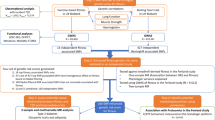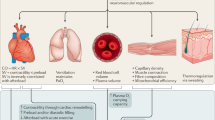Abstract
The definition of the term “environment” has broadened in the past 40 years to include knowledge generated from sequencing genes. Studies on animal responses to the environment have expanded to include selective lifestyle behaviors. Environmental lifestyle components interact with susceptibility genes to pass a threshold of biological significance such that a disease requires clinical treatment. Examples of environmental-gene interactions producing cystic fibrosis and asthma are described. The contributing role of physical inactivity to the epidemic of type 2 diabetes is presented with some of its underlying effectors. A lack of contractile activity by skeletal muscle is associated with less GLUT4 protein in the sarcolemma and a lower glucose uptake into the muscle. The pathways by which contractile activity signals an increase in glucose uptake differs from insulin signaling, but is remarkably similar to how hypoxia stimulates muscle to increase its glucose uptake.
“... the physiology of an organism cannot be described without considering its environmental interactions.”
—C. Ladd Prosser (23)
Access this chapter
Tax calculation will be finalised at checkout
Purchases are for personal use only
Preview
Unable to display preview. Download preview PDF.
Similar content being viewed by others
References
Azevedo JL, Carey JO, Pories WJ, Morris PG, Dohm GL. Hypoxia stimulates glucose transport in insulin-resistant human skeletal muscle. Diabetes 1995 Jun;44(6):695–8.
Barnes KC. Gene-environment and gene-gene interaction studies in the molecular genetic analysis of asthma and atopy. Clin Exp Allergy 1999 Dec;29 Suppl 4:47–51.
Beaudet, AL, CR Scriver, WS Sly, and D Valle. Genetics, biochemistry, and molecular basis of variant human phenotypes. In: The Metabolic and Molecular Bases of Inherited Disease 7th Ed, Vol 1, edited by Scriver CR, Beaudet AL, Sly WS, Valle D, Stanbury JB, Wyngaarden, JB, and Fredrickson, DS. New York, NY: McGraw-Hill; 1995, p 79.
Cartee GD, Douen AG, Ramlal T, Klip A, Holloszy JO. Stimulation of glucose transport in skeletal muscle by hypoxia. J Appl Physiol 1991 Apr;70(4): 1593–600.
Centers for Disease Control WEB page, United States
Crystal RG. Research Opportunities and Advances in Lung Disease. JAMA 2001 Feb 7;285(5):612–618.
Davidson, JK. Clinical Diabetes Mellitus. New York: Thieme, 1986, p 13–14.
Derave W, Hespel P. Role of adenosine in regulating glucose uptake during contractions and hypoxia in rat skeletal muscle. J Physiol 1999 Feb 15;515 (Pt 1):255–63.
Folk, GE. Introduction to Environmental Physiology, Philadelphia: Lea & Febiger, 1966, p. 14.
Foster, DW. Diabetes mellitus. In: Harrison’s Principles of Internal Medicine. Edited by Isselbacher KJ, Adams RD, Braunwald E, Petersdorf RG, and Wilson, JD. New York: McGraw-Hill, 1980, p1742–1743.
Goodyear LJ. AMP-activated protein kinase: a critical signaling intermediary for exercise- stimulated glucose transport? Exerc Sport Sci Rev 2000 Jul;28(3): 113–6
Harris MI, and RC Eastman. Early detection of undiagnosed diabetes mellitus: a US perspective. Diabetes Metab Res Rev 16:230–236, 2000.
Heath GW, Gavin JR, Hinderliter JM, Hagberg JM, Bloomfield SA, Holloszy JO. Effects of exercise and lack of exercise on glucose tolerance and insulin sensitivity. J Appl Physiol 1983 Aug;55(2):512–7.
Hu FB, Sigal RJ, Rich-Edwards JW, Colditz GA, Solomon CG, Willett WC, Speizer FE, Manson JE. Walking compared with vigorous physical activity and risk of type 2 diabetes in women: a prospective study. JAMA 1999 Oct 20;282(15): 1433–9.
Kennedy JW, Hirshman MF, Gervino EV, Ocel JV, Forse RA, Hoenig SJ, Aronson D, Goodyear LJ, Horton ES. Acute exercise induces GLUT4 translocation in skeletal muscle of normal human subjects and subjects with type 2 diabetes. Diabetes 1999 May;48(5):1192–7.
Lipman RL, Raskin P, Love T, Triebwasser J, Lecocq FR, Schnure JJ. Glucose intolerance during decreased physical activity in man. Diabetes 1972 Feb;21(2): 101–7.
Lynch J, Helmrich SP, Lakka TA, Kaplan GA, Cohen RD, Salonen R, Salonen JT. Moderately intense physical activities and high levels of cardiorespiratory fitness reduce the risk of non-insulin-dependent diabetes mellitus in middle-aged men. Arch Intern Med 1996 Jun 24;156(12):1307–14.
Mikines KJ, Sonne B, Farrell PA, Tronier B, Galbo H. Effect of physical exercise on sensitivity and responsiveness to insulin in humans. Am J Physiol 1988 Mar;254(3 Pt l):E248–59.
Mokdad AH, Ford ES, Bowman BA, Nelson DE, Engelgau MM, Vinicor F, Marks JS. Diabetes trends in the U.S.: 1990–1998. Diabetes Care 2000 Sep;23(9): 1278–83.
Mokdad AH, Ford ES, Bowman BA, Nelson DE, Engelgau MM, Vinicor F, Marks JS. The continuing increase of diabetes in the US. Diabetes Care 2001 Feb;24(2):412.
Pinhas-Hamiel O, LM Dolan, SR Daniels, D Standiford, PR Khoury, and P Zeitler. Increased incidence of non-insulin-dependent diabetes mellitus among adolescents. J Pediatr 128:608–615, 1996.
Pinhas-Hamiel O and P Zeitler. Type 2 diabetes in adolescents, no longer rare. Pediatr Rev 19:434–435, 1998.
Posser, CL. Environmental and metabolic animal physiology. New, NY: Wiley-Liss, 1991.
Seider MJ, Nicholson WF, Booth FW. Insulin resistance for glucose metabolism in disused soleus muscle of mice. Am J Physiol 1982 Jan;242(l):E12–8
Vague P, V Lassmann, C Grosset, and B Vialettes. Type II diabetes in young subjects. A study of 90 unrelated cases. Diabete Metab 13:92–98, 1987.
Weiss ST. Gene by environment interaction and asthma. Clin Exp Allergy 1999 Jun;29 Suppl 2:96–9.
Welsh MJ, L-C Tsui, TF Boat, and AL Beaudet. Cystic fibrosis. In: The Metabolic and Molecular Basis of Inherited Disease. 7th Ed, Vol edited by Scriver CR, Beaudet AL, Sly WS, Valle D, Stanbury JB, Wyngaarden, JB, and Fredrickson, DS. New York, NY: McGraw-Hill; 1995:p. 3799–3876.
Zerba KE, RE Ferrell, and CF Sing. Complex adaptive systems and human health: the influence of common genotypes of the apolipoprotein E (ApoE) gene polymorphism and age on the relational order within a field of lipid metabolism traits. Hum. Genet. 107:466–475,2000.
Author information
Authors and Affiliations
Editor information
Editors and Affiliations
Rights and permissions
Copyright information
© 2001 Springer Science+Business Media New York
About this chapter
Cite this chapter
Booth, F.W., Vyas, D.R. (2001). Genes, environment, and exercise. In: Roach, R.C., Wagner, P.D., Hackett, P.H. (eds) Hypoxia. Advances in Experimental Medicine and Biology, vol 502. Springer, Boston, MA. https://doi.org/10.1007/978-1-4757-3401-0_3
Download citation
DOI: https://doi.org/10.1007/978-1-4757-3401-0_3
Publisher Name: Springer, Boston, MA
Print ISBN: 978-1-4419-3374-4
Online ISBN: 978-1-4757-3401-0
eBook Packages: Springer Book Archive




